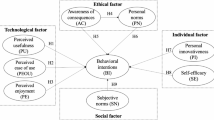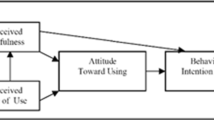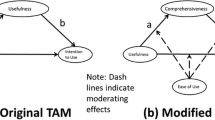Abstract
Higher education institutions typically express the quality of their degree programs by describing the qualities, skills, and understanding their students possess upon graduation. One promising instructional design approach to facilitate institutions’ efforts to deliver graduates with the appropriate knowledge and competencies is curriculum mapping. To support the complex activity of curriculum mapping and to address existing problems associated with current practices around unit guides, that many Australian higher education institutions are developing unit guide information systems (UGISs). This study examines factors influencing the acceptance and use of UGIS by unit conveners and academics. This study proposed a model for the acceptance of UGIS, which integrated key constructs from the technology acceptance model (TAM), social cognitive theory and model of PC utilization including seven main factors: perceived usefulness, perceived ease of use, attitude towards using the UGIS, intention to use the UGIS, social influence, unit guide specific self-efficacy, and unit guide specific anxiety. The model was tested on a sample of 134 unit guide users from 39 Australian universities and analyzed using structural equation modeling and partial least squares methods. Analysis showed that attitude, perceived usefulness, and perceived ease of use from the basic TAM model contributed significantly to explain the intention of academics and unit conveners to use UGIS. In addition, the integration of self-efficacy, anxiety and social influence as constructs were found to improve the fit of the model. Implications of the results are discussed within the context of unit guides and curriculum mapping.




Similar content being viewed by others
Explore related subjects
Discover the latest articles, news and stories from top researchers in related subjects.References
Anderson, R., Anderson, R., Davis, P., Linnell, N., Prince, C., Razmov, V., & Videon, F. (2007). Classroom presenter: Enhancing interactive education with digital ink. IEEE Computer, 40(9), 56–61.
Armstrong, J. S., & Overton, T. S. (1977). Estimating non-response bias in mail surveys. Journal of Marketing Research, 14(3), 396–402.
Bagozzi, R. P. (2007). The legacy of the technology acceptance model and a proposal for a paradigm shift. Journal of the Association for Information Systems, 8(4), 244–254.
Bandura, A. (1986). Social foundations of thought and action: A social cognitive theory. Upper Saddle River: Prentice-Hall.
Benbasat, I., & Barki, H. (2007). Quo vadis, TAM? Journal of the Association of Information Systems, 8(4), 211–218.
Bennet, S., Maton, K., & Carrington, L. (2011). Understanding the complexity of technology acceptance by higher education students. In T. Teo (Ed.), Technology acceptance in education: Research and issues (pp. 63–77). Rotterdam: Sense Publisher.
Cheung, C. M., & Lee, M. K. (2011). Exploring the gender differences in student acceptance of an internet-based learning medium. In T. Teo (Ed.), Technology acceptance in education research and issues (pp. 183–199). Rotterdam: Sense Publisher.
Chin, W. W. (1998). Issues and opinions on structural equation modeling. MIS Quarterly, 22(1), vii–xvi.
Chuttur, M. Y. (2009). Overview of the technology acceptance model: Origins, developments and future directions. Sprouts: Working papers on information systems, Indiana University, USA.
Clausen, J. M. (2007). Beginning teachers’ technology use: First-year teacher development and the institutional context’s affect on new teachers’ instructional technology use with students. Journal of Research on Technology in Education, 39(3), 245–261.
Compeau, D. R., & Higgins, C. A. (1995). Application of social cognitive theory to training for computer skills. Information Systems Research, 6(2), 118–143.
Davis, F. D. (1989). Perceived usefulness, perceived ease of use, and user acceptance of information technology. MIS Quarterly, 13(3), 319–340.
Davis, R., & Wong, D. (2007). Conceptualising and measuring the optimal experience of the elearning environment. Decision Sciences Journal of Innovative Education, 5(1), 97–126. doi:10.1111/j.1540-4609.2007.00129.x.
Dillon, A., & Morris, M. G. (1996). User acceptance of new information technology: Theories and models. In M. Williams (Ed.), Annual review of information science and technology (pp. 3–32). Medford, NJ: Information Today.
Gefen, D., Straub, D. W., & Boudreau, M. (2000). Structural equation modeling techniques and regression: Guidelines for research practice. Communications of AIS, 4(7), 1–79.
Hair, J. F., Black, W. C., Babin, B. J., & Anderson, R. E. (2010). Multivariate data analysis (7th ed.). Upper Saddle River, NJ: Prentice Hall.
Hu, P. J.-H., & Hui, W. (2011). Is technology-mediated learning made equal for all? Examining the influences of gender and learning style. In T. Teo (Ed.), Technology acceptance in education research and issues (pp. 101–124). Rotterdam: Sense Publisher.
Jones, D. (2009). Supporting curriculum mapping? (Web log Post). Retrieved from http://davidtjones.wordpress.com/2009/12/21/supporting-curriculum-mapping/
Kaplan, B., & Maxwell, J. A. (2005). Qualitative research methods for evaluating computer information systems. In J. Anderson, C. Aydin (Eds.), Evaluating the organizational impact of health care information systems: Methods and applications (pp. 30–55). doi:10.1007/0-387-30329-4_2
Kiraz, E., & Ozdemir, D. (2006). The relationship between educational ideologies and technology acceptance in pre-service teachers. Educational Technology & Society, 9(2), 152–165.
Kline, R. B. (2010). Principles and practice of structural equation modelling (3rd ed.). New York: Guilford Press.
Kumar, S. (2007). Student and professor perceptions of course web-site use in web-enhanced instruction. In C. Montgomerie & J. Seale (Eds.), Proceedings of world conference on educational multimedia, hypermedia and telecommunications (pp. 4321–4326). Chesapeake, VA: AACE.
Kuna, A. S. (2012). Learner interaction patterns and student perceptions toward using selected tools in an online course management system. Graduate Theses and Dissertations.
Lahaut, V., Jansen, H., Mheen, D., Garretsen, H., Verdurmen, J., & Dijk, A. (2003). Estimating non-response bias in a survey on alcohol consumption: Comparison of response waves. Alcohol and Alcoholism, 38(2), 128–134.
Li, L. (2010). A critical review of technology acceptance literature. Southwest Region of the Decision Sciences Institute. Retrieved from http://www.swdsi.org/swdsi2010/SW2010_Preceedings/papers/PA104.pdf
Li, C., & Ku, Y. (2011). The effects of persuasive messages on system acceptance. In Proceedings of Pacific Asia conference on information systems (PACIS). Retrieved from http://aisel.aisnet.org/pacis2011/110
Oliver, B. (2010). Teaching fellowship: Benchmarking partnerships for graduate employability (Final Report). Sydney, NSW: Australian Learning and Teaching Council. Retrieved from http://tls.vu.edu.au/portal/site/design/resources/Benchmarking%20Partnerships%20for%20Graduate%20Employability.pdf
Park, S. Y., Nam, M. W., & Cha, S. B. (2012). University students’ behavioural intention to use mobile learning: Evaluating the technology acceptance model. British Journal of Educational Technology, 43, 592–605. doi:10.1111/j.1467-8535.2011.01229.x.
Qualtrics Labs, I. (2009). Qualtrics. Provo, Utah: Qualtrics Labs Inc.
Rigby, B., Wood, L., Clark-Murphy, M., Daly, A., Dixon, P., Kavanagh, M. et al. (2010). Review of graduate skills: Critical thinking, team work, ethical practice and sustainability. Australian Learning & Teaching Council Project: Embedding the Development and Grading of Generic Skills Across the Business Curriculum.
Ring, J. K., Kellermanns, F. W., Pearson, A. W., & Pearson, R. A. (2012). The use of a web-based course management system causes and performance effects. Journal of Management Education, 37(6), 854–882. doi:10.1177/1052562912459853.
Ringle, C. M., Wende, S., & Will, A. (2005). SmartPLS, 2.0 (Beta). Hamburg, Germany: SmartPLS. Retrieved from http://www.smartpls.de
Schepers, J., & Wetzels, M. (2007). A meta-analysis of the technology acceptance model: Investigating subjective norm and moderation effects. Information & Management, 44(1), 90–103.
Smarkola, C. (2007). Technology acceptance predictors among student teachers and experienced classroom teachers. Journal of Educational Computing Research, 31(1), 65–82.
Tenenhaus, M. (2008). Structural equation modelling for small samples. Working Paper Number 885, HEC Paris, Jouy-en-Josas.
Teo, T. (2008). Pre-service teachers’ attitude towards computer use: A Singapore survey. Australasian Journal of Educational Technology, 24(4), 413–424.
Teo, T., & Fan, X. (2013). Coefficient alpha and beyond: Issues and alternatives for educational research. The Asia-Pacific Education Research, 22(2), 209–213.
Teo, T., & Lee, B. C. (2010). Explaining the intention to use technology among pre-service teachers. Campus-Wide Information Systems, 27(2), 60–67.
Thompson, L. R., Higgins, A. C., & Howell, M. J. (1991). Personal computing: Toward a conceptual model of utilization. MIS Quarterly, 15(1), 124–143.
Triandis, H. C. (1977). Interpersonal behaviour. Monterey, CA: Brooke/Cole.
Urbach, N., & Ahlemann, F. (2010). Structural equation modeling in information systems research using partial least squares. Journal of Information Technology Theory and Application, 11(2), 5–40.
Venkatesh, V., & Bala, H. (2008). Technology acceptance model 3 and a research agenda on interventions. Decision Sciences, 39(2), 273–315.
Venkatesh, V., & Davis, F. D. (2000). A theoretical extension of the technology acceptance model: Four longitudinal field studies. Management Science, 46(2), 186–204.
Venkatesh, V., Morris, M. G., Davis, G. B., & Davis, F. D. (2003). User acceptance of information technology: Toward a unified view. MIS Quarterly, 27(3), 425–478.
Wolk, R. M. (2009). Using the technology acceptance model for outcomes assessment in higher education. Information Systems Education Journal, 7(43), 1–18.
Zhang, C., Huang, J., Chen, J., Li, M., Lee, H. J., Choi, J. et al. (2010). Research on adoption of mobile virtual community in China and Korea. International Conference on Mobile Business, pp. 220–229. doi:10.1109/ICMB-GMR.2010.26
Author information
Authors and Affiliations
Corresponding author
Appendix
Appendix
The following scalar items were measured using a 5-point Likert scale ranging from 1 = strongly disagree, 2 = disagree, 3 = neutral, 4 = agree and 5 = strongly agree.
Perceived usefulness (PU)
-
PU1: Using the unit guide tool improves the quality of the work I do.
-
PU2: Using the unit guide tool enables me to accomplish tasks more quickly.
-
PU3: Using the unit guide tool enables me to accomplish curriculum mapping more quickly.
-
PU4: Using the unit guide tool enhances my effectiveness on the job.
-
PU5: I would find the unit guide tool useful in my job.
-
PU6: If I use the unit guide tool, I will spend less time in curriculum mapping.
-
PU7: Using the unit guide tool increases my productivity.
-
PU8: Using the unit guide tool makes it easier to do my job.
Attitude towards using unit guide tool (ATT-UGIS)
-
ATT1: Using the unit guide tool is a good idea.
-
ATT2: Using the unit guide tool for curriculum mapping is a good idea.
-
ATT3: The unit guide tool makes work more interesting.
-
ATT4: I like working with the unit guide tool.
Perceived ease of use (PEOU)
-
PEOU1: It would be easy for me to become skillful at using the unit guide tool.
-
PEOU2: My interaction with the unit guide tool is clear and understandable.
-
PEOU3: It is easy for me to remember how to perform tasks using the unit guide tool.
-
PEOU4: Using the unit guide tool takes too much time from my normal duties.
-
PEOU5: Working with the unit guide tool is so complicated.
-
PEOU6: Using the unit guide tool involves too much time undertaking mechanical operations.
-
PEOU7: It takes too long to learn how to use the unit guide tool to make it worth the effort.
-
PEOU8: I (would) find the unit guide tool easy to use.
-
PEOU9: I (would) find the unit guide tool easy for curriculum mapping.
Intention towards using unit guide tool (INT-UGIS)
-
INT1: I intend to use the unit guide tool frequently next semester.
-
INT2: I intend to use the unit guide tool regularly next semester.
-
INT3: I intend to use the unit guide tool next semester to assist me.
-
INT4: I intend to use the unit guide tool for curriculum mapping next semester.
Unit guide specific anxiety (UGIS-S-ANX)
-
ANX1: I feel apprehensive about using unit guide tool.
-
ANX2: I feel apprehensive about using unit guide tool for curriculum mapping.
-
ANX3: I hesitate to use the unit guide tool for fear of making mistakes I cannot correct.
-
ANX4: The unit guide tool is somewhat intimidating to me.
Unit guide specific self efficacy (UGIS-S-SE)
-
SE1: I could complete the job using the unit guide tool on my own/without support.
-
SE2: I could perform curriculum mapping using a unit guide tool on my own/without support.
-
SE3: I could complete the job using the unit guide tool if I could call someone for help.
-
SE4: I could complete the job using the unit guide tool, if I had a lot of time to complete my job.
-
SE5: I could complete the job using the unit guide tool, if I had just the built-in help facility.
-
SE6: I could complete the job using the unit guide tool, if I had never used a system like it before.
-
SE7: I could complete… if I had used similar information systems like this one before to do the job.
Social influence (SI)
-
SI1: I anticipate I will use the tool because of the proportion of co-workers who use this tool.
-
SI2: I anticipate the organization will support the use of the unit guide tool.
-
SI3: I anticipate the organization will support the use of the unit guide tool for curriculum mapping.
-
SI4: I anticipate people who influence my behaviour will think that I should use the unit guide tool.
-
SI5: If I use the unit guide tool, my co-workers will perceive me as competent.
Rights and permissions
About this article
Cite this article
Atif, A., Richards, D., Busch, P. et al. Assuring graduate competency: a technology acceptance model for course guide tools. J Comput High Educ 27, 94–113 (2015). https://doi.org/10.1007/s12528-015-9095-4
Published:
Issue Date:
DOI: https://doi.org/10.1007/s12528-015-9095-4




